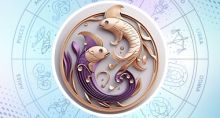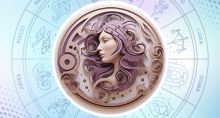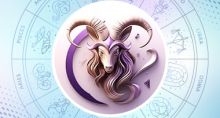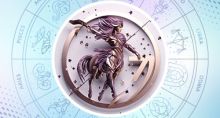The Story of Ravana
Every hero needs an anti-hero who is worth his mettle. The 10-headed Ravana certainly is one such anti-hero who inspires awe, wonder, and even admiration in some circles. For he was no ordinary Asura but one who was very learned, knowledgeable, and accomplished. As the antagonist of the Ramayana and the demon king of Lanka who abducted Rama’s wife, Sita, to avenge the insult to his sister, he has a central role in the epic.
Ravana was an ardent devotee of Shiva, a great scholar, a good ruler, a Veena maestro, an author, and an excellent astrologer. He wrote two books - Ravana Samhita (on astrology) and Arka Prakasham (on Siddha medicine). He had immense knowledge of Ayurveda and black magic. He could control the planets. He also had a pushpakviman (a flying chariot) which actually belonged to his stepbrother, Kubera. Further, he was a master of Tantra vidya (the science of creating optical illusions), which he used to good effect in battles against his foes.
Ravana was the grandson of Pulastya, who was one of the 10 Prajapatis of Brahma and also a Saptarishi during the age of Manu. His parents were Sage Vishravan and Kaikashi. So, he is regarded as half Brahmin (sage) and half Asura (demon). Though he is depicted with 10 heads, he was not born with all ten heads.
Ravana was born in Devagana. Ravana had 7 brothers and 2 sisters. They were Kubera, Kumbhakarna, Vibhishana, Khara, Dushana, Ahiravan, Kumbhini, Sahastra Ravana, and Shurpanakha. It is Shurpanaka who kickstarts the events that lead to Sita’s abduction by Ravana. He also had a stepbrother, Kubera, from whom he usurped the kingdom of Lanka. His maternal grandfather, Sumali, was responsible for making Ravana the king of Lanka by advising him to ask for boons from Brahma, defeat Kubera, and establish the rule of the Rakshasas in the three worlds.
Ravana had three wives - Mandodari (daughter of the divine architect Maya), Dhanyamalini, and a third wife. Meghanada, Atikaya, Akshayakumara, Narantaka, Devantaka, Trishira, and Prahasta were the sons from his 3 wives.
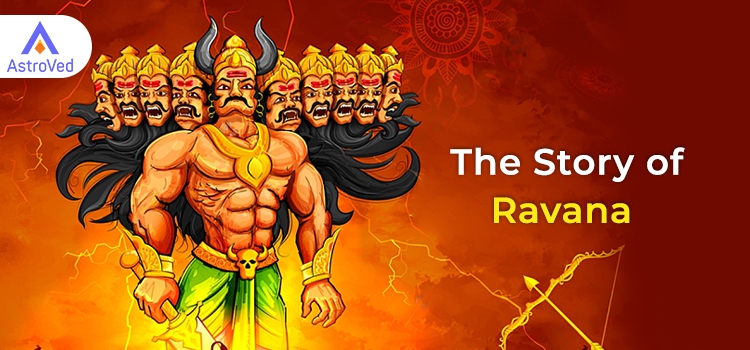
Ravana and Shiva
Once, Ravana tried to bring Mount Kailash to Lanka in order to please his mother. When he lifted the mountain, an angry Shiva crushed his forehand beneath the mountain. Then Ravana tore off one of his arms and made a musical instrument. He ripped out sinews to form its strings. Then, using the newly invented ravanhattha, he sang the praises of Shiva. This went on for 1000 years. On hearing the beautiful music, Shiva wept and forgave him and then began dancing with fury and passion. This dance by Shiva is the ‘tandav,’ and the chants came to be called Shiva Tandav Stotram. It is also said that Shiva blessed him and gave him an invincible sword and a powerful linga to worship him with.
Ravana also performed severe tapasya (penance) to please Shiva on the banks of the Narmada river. To please the deity, Ravana supposedly sacrificed his head, but the head grew back. Ravana again sacrificed his head, and it grew back again. This happened ten times. So he was able to continue his penance. Shiva granted ten heads to Ravana, which he had sacrificed.
Ravana’s ten heads symbolize the six Shastras (sacred scriptures of Hinduism which comprise four categories: the sruti, smriti, purana, and tantra) and the four Vedas that Ravana was a master of. Thus, he was a great scholar and highly intelligent. He had mastery over 64 types of knowledge and all arts of weaponry. He compiled the Vedas with the relevant musical svara (notes). His Shiva Tandava Stotra is the most popular hymn in praise of Shiva. He also captured the 9 planets to ensure that they did not move to unfavorable positions in his son Meghanad’s (Indrajit) birth chart. So, all of them, except Saturn/Shani, occupied the 11th house in the boy’s chart. Ravana then imprisoned Shani in a dungeon, from where he was freed by Hanuman during his visit to Lanka in search of Sita.
Ravana’s 10 heads also signify the 10 emotions. They are Kama (lust), Krodha (anger,) Moha (delusion), Lobh (greed), Mada (pride), Maatsarya (envy), Manas (mind), Buddhi (intellect), Chit (will), and Ahamkara (ego).
Once, Mahabali, a great Asura king, advised Ravana to shun nine emotions and to retain only intellect. But Ravana refused, saying that he needed all these emotions to make him a complete man. The one head representing Buddhi controlled his destiny while the other heads controlled his actions. This eventually led to his destruction. He became a slave to his senses, and being unable to control his desires, he ended up destroying himself and his clan, and his kingdom was also reduced to ashes. The inability to harness his powers despite having immense knowledge was a huge regret for him as he lay dying on the battlefield.
Ravana Gets Boons from Brahma
Ravana, along with his two brothers, Kumbhakarna and Vibhishana, did penance on Mount Gokarna for 11,000 years and received boons from Brahma. Ravana gained a boon that would make him invincible to all the creations of Brahma, save human beings. He also received a chariot, weapons, and the ability to shapeshift.
As per the Ramayana, the demigods sought the help of Brahma to defeat Ravana, who was causing havoc on Earth. Vishnu then promised to incarnate as a human (Rama) and kill Ravana.
Vishnu's Doorkeeper
The Bhagavata Purana says that Ravana and Kumbhakarna were reincarnations of Jaya and Vijaya, who were the gatekeepers at Vaikunta (Vishnu’s abode). They were cursed to take birth on Earth.
The gatekeepers denied entry to the Sanatha Kumara monks who, due to their powers and austerity, looked like young children. The monks cursed them for their insolence. So they were expelled from Vaikunta and born on Earth.
But Vishnu gave them two options. They could be born 7 times as normal mortals and Vishnu devotees. Or they would be born strong and three times as powerful, but as Vishnu’s enemies. Eager to be reunited with Vishnu, they chose the latter option.
Their first births were as Hiranyakashipu and his brother Hiranyaksha in Satya Yuga. They were both slain by earlier avatars of Vishnu, Varaha, and Narasimha. Their second births were as Ravana and Kumbhakarna in Treta Yuga. Their third births were as Dantavakra and Shishupala in the Dvapara Yuga. Both were killed by Krishna, the eighth avatar of Vishnu.
How Ravana Became the King of Lanka
The divine architect Vishwakarma created the magnificent city of Lanka. Originally, the divine treasurer, Kubera, was the owner of the city of Lanka. Ravana ordered Kubera to cede Lanka to him and threatened to take it by force if he refused. Lanka prospered under Ravana.
Ravana ruled Lanka for several years before Rama killed him. It is said that his rule was from 2554 to 2517 BC. During his reign, there were great advancements in science and medicine. Ravana was a great physician and even published seven books on Ayurveda. He also wrote Ravana Sanhita.
Conclusion
Ravana is a perfect example that all the accomplishments and abilities of a person cannot save him from damnation and the wrath of god if he flouts the law of Dharma. However, there are people who admire this anti-hero, and there are many temples for this great Shiva devotee, mostly in North India.










